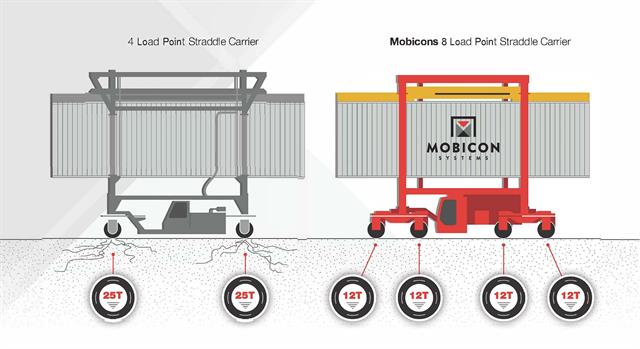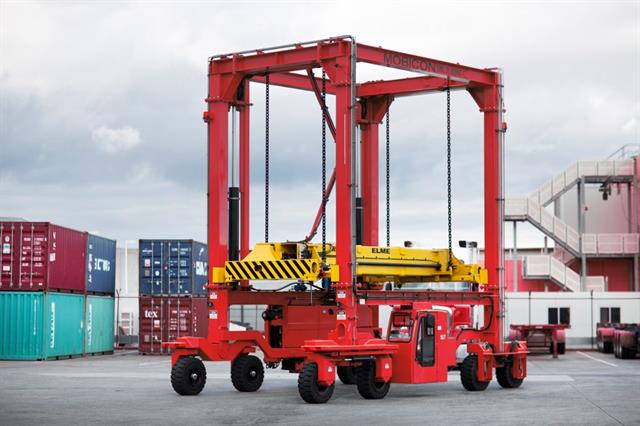 How load points on a mini straddle carrier can damage a yard |
A lot is written about point loads on trucks and trailers, and it is common knowledge that high point loads damage roads, bridges and underground pipes and drains.Tom Schults Managing Director of Mobicon Mini Straddle Carriers says.
"Point Loads are important when using machinery like container handlers in an industrial yard, as damage to the ground structures occurs, when point loads exceed the capacity of the yard.
'Mini Straddle Carriers are becoming increasingly popular for operations who handle containers outside of the harbour as they cost much less to purchase, and they have a lower cost to maintain and run than the large container forklifts and reach stackers". The average industrial yard in Australia is constructed for 5-Tonne Forklifts and B-Doubles and is generally made out of 200mm concrete with one layer of steel reinforcement, or the equivalent bitumen which a Mini Straddle Carrier with 8 point loads is suitable for.
However, using high point load container handler (typically with less than 4 point loads) on this type of yard will result in cracking of the concrete (sometimes within only weeks), gouging of the bitumen and damaging of pipes and drains.
Point Loads and Wheel Pressure are often confused
Point Load = the total number of kilograms
Wheel Pressure = total number of kilograms per square centimeter.A machine with less may have larger tyres to reduce the pressure the wheels put on the ground surface, but the point load is still very high causing damage.
That's why Road Authorities are concerned about loads, and not wheel pressures, as it is the point load weight that will damage a bridge, yard or depot and not the pressure. Fitting larger wheels is, according to Civil Engineers not suitable - as the point load stays the same.
Most people in the logistics industry understand the huge point weights that a reach stacker or container forklift place on a yard; point loads of 30 Tonne and up to 50 Tonne are common. Therefore, yards where these machines are being employed, have a special heavy duty yard surface to carry the huge point load weights.
 Mobicons TF2 has 8 load points and will not damage the average yard |
However, for first time buyers of container handlers, who operate on a standard industrial yard point load vs. wheel pressure can become confusing, and buyers can fall into the trap of buying a cheap container handler with a very high point load which has very costly consequences in the longer term including: a large yard repair bill, the container handler having to be stood down as it is not fit for purpose, new concrete/yard needing to be poured, and the yard being out of commission for four weeks due to curing requirements.
The good news is that with some basic knowledge and understanding of point loads, these costs can be avoided. As mentioned earlier most operators understand that Reach Stackers and Container Forklifts have huge point loads of 30 Ton and more, and are not suitable for normal industrial yards. So for companies who do not have specially constructed heavy yard surfaces, machinery such as a Mini Straddle Carrier is a good alternative, as long as the particular model has the correct point loads. According to Civil Engineers, to avoid yard damage the load needs to be low and spread-out over as many "load-points" as possible. A load-point is where the load hits the ground, and can be one wheel, or double wheels (two wheels close together is one load point).
At
Mobicon we understand this, and therefore every Mobicon Mini Straddle Carrier has four axles, and thus eight load-points.
Some Brands only have two axles which places double the load on the yard, and some claim that placing dual wheels on each corner will lessen the damage, but this is not the case. Civil Engineers will consider dual wheels as one load point, and the yard will be damaged when using two-axle container handlers.
Many companies easily accept that placing 25 Tonne containers on a truck with only one steer axle and one drive axle is not a good practice, however they fail to extend this knowledge to other machinery including container handling machinery, which can result in huge yard repair bills for companies.
It is easy for operations to safeguard themselves against huge yard damages caused by point load weight by ensuring that they:
- Know your yard surface; when in doubt, consult a Civil Engineer.
- Give the Civil Engineer the point loads and axle spacing of the Machinery you propose to use, as well as the tyre/wheel configuration.
The small investment in knowing your yard, and knowing a machines point loads, will give you many years of service without the huge cost of repairs, and in our view it is well worth it.
In just the last few years we have confirmation of at least eleven companies who have had to deal with major yard problems after using 3-wheel (three-point load straddle carriers). By simply knowing your machinery point load - you can avoid being one of them.
To understand more about point loads watch our video at:
Mobicon Systems ContactFor further information please contact:Jesse Schultz - Business Development Manager
Email: send an email
Mb: +61 (0) 427 57 57 22About Mobicon Mini Straddle Carriers
Established in 1994, Mobicon Systems designs and manufactures Mini Straddle Carriers that provide cost effective, quick and reliable container handling solutions. Suitable for a wide variety of terrains, the Mobicon's unique 4 axle design is the only Mini Straddle Carrier on the market today recognised by civil engineers not to damage the average yard. Mobicon Machines are used all over the globe in industries such as Defence Forces, Customs, Ports, Logistics Companies, Mining and Import/Export operations who require fast and efficient container handling operations. Mobicon Mini Straddle Carriers are a safer, and more cost effective solution than forklifts or side loaders and are durable, easy to use, and provide superior maneuverability. Mobicons most popular models include the TF2 which can stack one on one, and uses an ElME spreader to lift the containers meaning the driver does not have to exit the cabin. Plus the 2T which can go anywhere including under awnings and be used in small warehouse conditions.